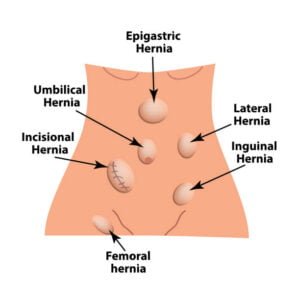Umbilical Hernia: Symptoms, Treatment and Recovery

Individuals affected by umbilical hernia must understand its causes, symptoms and treatment options for better awareness. This article focuses on the details of umbilical hernias, covering aspects such as diagnosis, susceptibility factors, surgical techniques, and post-surgery recovery guidelines. By exploring these topics, we aim to provide valuable insights and promote a smoother healing process.
What is an umbilical hernia?
A hernia is a bulge in the abdomen due to weakness of the abdominal muscles. The resultant defect allows abdominal fat or organs such as intestine to protrude through. This can happen in both men and women and the incidence increases with age.
Hernias are named according to their location on the body. Umbilical or paraumbilical hernias are located around the centre of the umbilicus ring.
Symptoms and diagnosis of umbilical hernia
Umbilical hernias are common. Patients can present with the following symptoms:
- Swelling or bulge around the umbilicus that gets bigger with standing and disappears with lying down. It may also appear like an eccentric protrusion at the umbilicus.
- Discomfort or pain over the swelling especially while straining and/or during physical activity.
- In certain cases, a portion of the intestine may pass through the defect and get trapped inside the hernia. This may lead to blockage of the intestine. The patient will experience constant, severe pain associated with abdominal distension and vomiting. Umbilical hernia is more likely to obstruct than any other ventral or incisional hernia. This is an emergency that likely requires urgent surgery.
- Scans done for other reasons (e.g., CT scan) may detect umbilical hernia in some patients who have no symptoms.
Routine examination usually leads to the diagnosis of most hernias. In equivocal or complex cases, the surgeon can order an ultrasound or CT scan.


What are the risk factors for umbilical hernia?
Females have a higher occurrence of umbilical hernias compared to males. In adults, pregnancy, obesity, or other diseases such as ascites can lead to the development of most umbilical hernias due to increased intra-abdominal pressure.
During the gestation period, it is common to find a small umbilical hernia in up to 80% of pregnant women. In the majority of cases, the hernia is asymptomatic, and a conservative approach is preferred. After the postpartum period, your surgeon will discuss with you the role and timing of surgery.

What are the treatment options for umbilical hernia?
Almost all hernias need surgical repair to treat symptoms and to prevent complication such as strangulation. Without treatment, the hernia will only get bigger with time. Your surgeon will determine whether a laparoscopic (keyhole) or an open umbilical hernia repair is suitable for you after a thorough examination. Surgeons normally use a surgical prosthesis (mesh) to strengthen the weakened area of the abdominal wall.
The umbilical hernia operation is normally carried out under general anaesthesia but occasionally it can be performed under spinal anaesthesia.


Example of meshes used in umbilical hernia surgery
What you need to know about umbilical hernia surgery?
Open umbilical hernia surgery
Typically, the surgeon performs this by making an incision under the umbilicus and accessing the area from outside. The wound is then deepened to the muscle layer, and the surgeon reduces the bulge while repairing the weakened area with a mesh. Sutures are typically utilized to secure the mesh in place.
Laparoscopic (keyhole) umbilical hernia surgery
Surgeons typically reserve laparoscopic hernia repair for larger umbilical hernias with significant defects. During laparoscopic repair, they utilize a laparoscope (a tiny camera) for visualization. They reduce the hernia using laparoscopic instruments and place a mesh, which they hold in place with absorbable tackers..
Some advantages of laparoscopic surgery:
- Smaller wounds, less pain, faster return to usual activities
- Better option to repair a recurrent hernia after a previous open surgery.

What preparation is required for the umbilical hernia surgery?
Depending on your medical conditions, pre-operative preparations may include:
- Blood tests
- Chest X ray
- Electrocardiogram (ECG)
You will need to fast the night before the umbilical hernia surgery, but continue to take essential medications e.g., anti-hypertensive as instructed by your surgeon. You should stop blood thinning medications like aspirin or a week before the surgery.
What should you expect for post umbilical hernia surgery recovery and expectations?
- Discharge: Most patients go home on the same day of surgery or the day after.
- Discharge criteria: You will be able to be discharged once you are fully awake, ambulant, tolerate diet, and able to pass urine.
- Pain management: Soreness over the wound area can be easily managed by prescribed painkillers.
- Resuming activities: Most patients are able to resume daily activities within the first week.
- Abdominal binder: An abdominal binder is usually prescribed to be worn for at least 4 to 6 weeks as a support.
- Strenuous activities: Avoid strenuous activities such as heavy lifting for the next few weeks until permitted by your surgeon.
- Follow-up appointment: You will be seen in the clinic in 1 to 2 weeks after the surgery to review the wound and any symptoms.
- Contact your surgeon: Call your surgeon if you experience persistent fever, worsening abdominal pain with nausea and vomiting, or wound problems such as swelling, bleeding, or discharge.

Other Hernia Surgery
Consult Us

Dr LEE Kuok Chung
Senior Consultant General Surgeon
Subspeciality interest: Colorectal, Advanced Endoscopy and Robotic Surgery

Dr TAN Wee Boon
Senior Consultant General Surgeon
Subspeciality interest: Thyroid, Hernia and Endocrine Surgery

Dr KIM Guowei
Senior Consultant General Surgeon
Subspeciality interest: Upper Gastrointestinal, Bariatric and Robotic Surgery
Crest Surgical Practice
Healing Hands, Compassionate Hearts: Your Partner in Surgical Care

